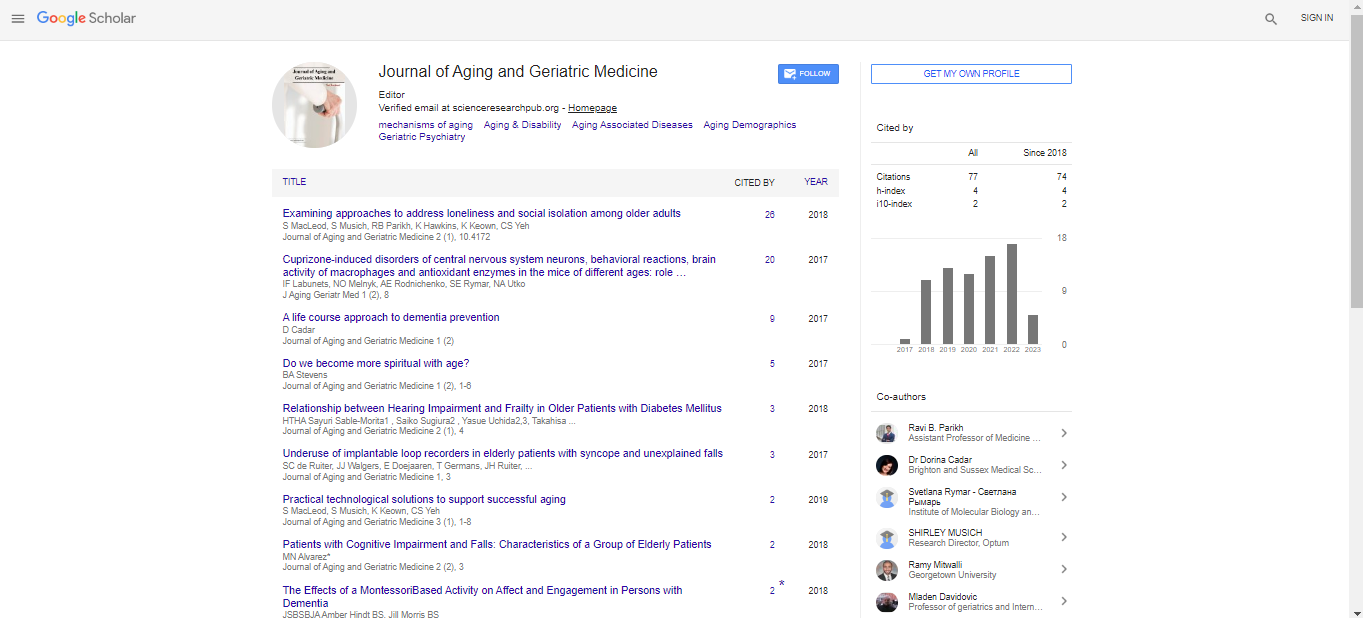Commentary, J Aging Geriatr Med Vol: 8 Issue: 1
A Short Note on Democratic Aging
Yuchard Cllton*
Department of Protozoology, Institute of Tropical Medicine (NEKKEN), Nagasaki University, Nagasaki, Japan
- *Corresponding Author:
- Yuchard Cllton
Department of Protozoology,
Institute of Tropical Medicine (NEKKEN),
Nagasaki University,
Nagasaki,
Japan
E-mail: yuchard_cllton@gmail.com
Received date: 04 November, 2023, Manuscript No. AGM-23-119220;
Editor assigned date: 07 November, 2023, PreQC No. AGM-23-119220 (PQ);
Reviewed date: 21 November, 2023, QC No. AGM-23-119220;
Revised date: 15 August, 2024, Manuscript No. AGM-23-119220 (R);
Published date: 22 August, 2024, DOI: 10.4172/2576-3946.1000186
Citation: Cllton Y (2024) A Short Note on Democratic Aging. J Aging Geriatr Med 8:1.
Description
Global population aging is posing an unprecedented range of concerns, including changing rates of disease, rising health and longterm care costs, a lack of workers, dissaving, and possible issues with economic security in old life. Consider longer life lengths to be extremely beneficial to human wellbeing, especially longer healthy life spans. This essay's first portion offers a statistical summary of the aging of the world's population and the variables that contribute to it. A few of the main issues brought on by the aging of the general population are described in the second part.
The aging of the population is an indicator of our achievement in controlling our reproduction and increasing lifespan. Families in aging societies alter as a result of the demographic shifts brought about by population aging. Concurrently, alterations in demographic patterns, including getting married and having kids, have changed how society is structured throughout generations. Each of these phenomena has also led to an increase in the variety of family structures, raising issues concerning society and personal accountability for long-term wellbeing. Different nations have different methods to social welfare, but even in the most giving, families are still the most dependable and favoured providers of support for people in need. The focus of demographic research on living arrangements, assistance, and family dynamics has shifted from family changes to the role of the publicprivate split in meeting the requirements of aging people.
Methodological techniques that make studies of families and intergenerational connections more realistic and complicated have also been made possible by demography. Macro simulation and microsimulation techniques to family change have been created and refined by demographers, allowing distributions of family types to be projected for planning and policy reasons.
Because older people often have higher demands and make less economic contributions than younger, working-age persons, population aging presents issues. For instance, functional limits the need for assistance with daily chores, illness, health shocks, and hospitalizations are all more common in the elderly population. The difficulty of meeting these growing age-related demands is exacerbated by older people's reduced labor incomes as a result, families and governments frequently foot the bill for their needs, both market and nonmarket. The negative economic effects of aging can be avoided in wealthy nations provided health and social security systems are able to sufficiently serve the demands of the elderly. The financial cost of aging, however, is more likely to fall on families or the elderly themselves in LMICs, where overall income levels are far lower and welfare programs may not exist or operate poorly. The possibility of aging without the means to care for the elderly has led to worries that low and middle-income countries are "growing old before rich." Examining how far this viewpoint is supported by current economic and demographic developments is the second major objective of the research.
Growing lifespan and decreasing fertility are two potentially connected demographic variables that lead to population aging. Longevity increases the number of older individuals who survive, which boosts the population's average age. There are fewer newborns as fertility declines, and as this impact persists, there are fewer younger people overall. Out of the two factors, decreasing fertility is currently responsible for the majority of global population aging. More precisely, the main cause of the population aging in the most industrialized nations in the globe is the significant drop in the global birth rate during the past 50 years. The population of developing countries will age much more quickly than that of already industrialized nations since many of them are undergoing rapid fertility changes.
Conclusion
Over the next three decades, the pace of population aging is expected to rise; nevertheless, few nations are aware of whether the elderly population is living longer and in better health. A "compression of morbidity" would suggest a decrease in old age impairment, whereas an expansion would result in an increase in ill health as life expectancy rose. A different choice has been made for a "dynamic equilibrium".
 Spanish
Spanish  Chinese
Chinese  Russian
Russian  German
German  French
French  Japanese
Japanese  Portuguese
Portuguese  Hindi
Hindi 